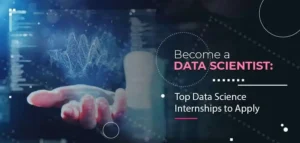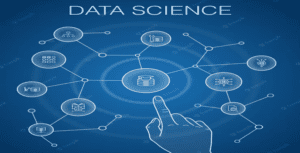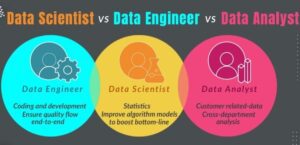The integration of data science, engineering, and analysis has become essential in today’s rapidly evolving technological landscape. With the increasing reliance on data-driven insights, professionals in these fields play a pivotal role in driving innovation and facilitating informed decision-making across industries. By harnessing their expertise and collaborating with diverse teams, they enable organizations to leverage the power of data to gain a competitive edge and achieve their strategic goals.

-
Data Analyst:
Professionals possessing skills in interpreting data, utilizing statistical techniques to evaluate results, and delivering regular reports. Often, their primary responsibility revolves around examining and comprehending information for the purpose of assisting enterprises to make informed choices.
Data Wrangling:
- Data cleaning and transformation to ensure accuracy and consistency.
- Identifying and resolving data quality issues.
- Merging data from multiple sources.
- Data Exploration and Analysis:
- Applying statistical techniques like hypothesis testing, regression analysis, and time series analysis.
- Identifying trends, patterns, and anomalies.
- Creating compelling visualizations to communicate insights.
- Reporting and Communication:
- Delivering regular reports and presentations to stakeholders.
- Translating complex data into actionable insights for non-technical audiences.
- working together with different teams to promote data-driven decision-making.
Data Wrangling:
- Data cleaning and transformation to ensure accuracy and consistency.
- Identifying and resolving data quality issues.
- Merging data from multiple sources.
- Data Exploration and Analysis:
- Applying statistical techniques like hypothesis testing, regression analysis, and time series analysis.
- Identifying trends, patterns, and anomalies.
- Creating compelling visualizations to communicate insights.
- Reporting and Communication:
- Delivering regular reports and presentations to stakeholders.
- Translating complex data into actionable insights for non-technical audiences.
- Working with other teams to make data-driven decisions.
- Data Exploration and Analysis:
-
Machine Learning Engineers:

Professionals who specialize in designing, constructing, and executing machine learning algorithms and systems. They are specifically focused on developing artificial intelligence models and frameworks that can acquire knowledge without the need for explicit programming.
- Model Design and Development:
- Choosing the right algorithms and architectures for specific tasks.
- Training and optimizing machine learning models.
- Automating model training and deployment processes.
- Production-Ready Systems:
- Integrating models into existing systems and workflows.
- Monitoring model performance and ensuring scalability.
- Addressing issues like bias and explainability.
- Cutting-Edge Research and Innovation:
- Staying up-to-date with the latest advancements in machine learning.
- Exploring new applications and potential future directions.
-
-
-
Data Engineer:
-
-

Individuals responsible for designing, erecting, and maintaining systems that facilitate the management of large volumes of information. Their role involves constructing and improving data pipelines to ensure their availability for analytical purposes.
-
-
- Data Infrastructure Design:
- Choosing the right data storage solutions (databases, data warehouses, and cloud platforms).
- Designing and building data pipelines for efficient data flow.
- Implementing data security and access control measures.
- Data Pipelines and ETL:
- Extracting data from diverse sources.
- Transforming data into a consistent format.
- Loading data into target systems for analysis.
- Data Quality and Governance:
- Monitoring data quality and ensuring accuracy.
- Implementing data governance policies and procedures.
- Collaborating with data analysts and scientists to ensure data integrity.
- Data Infrastructure Design:
-
-
Business Analysts:
-
-
These professionals are the ones who connect data analytics with business decision-making by analyzing and translating data to aid companies in making informed strategic choices.
-
-
- Business Understanding and Problem Identification:
- Understanding the business context and challenges.
- Identifying opportunities where data can drive value.
- Defining key performance indicators (KPIs) for success.
- Data Analysis and Interpretation:
- Accessing and analyzing relevant data from various sources.
- Identifying trends, patterns, and insights that inform business decisions.
- Communicating findings in a clear and actionable manner.
- Strategic Recommendations and Implementation:
- Developing data-driven recommendations for business improvement.
- Monitoring and evaluating the impact of data-driven initiatives.
- Collaborating with cross-functional teams to implement data-driven solutions.
- Business Understanding and Problem Identification:
-
-
Data Scientist (Specialized Roles):
-
-
In the field of data science, various job opportunities require specific skills and knowledge. These positions include NLP researchers, computer vision experts, and AI scientists. Each position focuses on a unique area, such as speech recognition or integrating computer vision methods, while also exploring cutting-edge research related to artificial intelligence.
-
-
- NLP Researchers:
- Developing algorithms for natural language processing tasks like speech recognition, machine translation, and sentiment analysis.
- investigating the relationship between AI and language.
- Computer Vision Experts:
- Building algorithms for image and video analysis, object detection, and scene understanding.
- Applying computer vision to various fields like robotics, healthcare, and autonomous vehicles.
- AI Scientists:
- Focusing on the theoretical foundations of artificial intelligence, including machine learning, deep learning, and reinforcement learning.
- Conducting research to advance the field of AI and develop new applications.
- NLP Researchers:
-
-
Data Visualization Specialist:
-
-
People who are experts in producing graphical representations of data with the aim to facilitating comprehension and appreciation of its importance.
-
-
- Visual Design and Storytelling:
- Creating visually appealing and informative charts, graphs, and dashboards.
- Using data visualization principles to communicate complex information effectively.
- Tailoring visualizations to specific audiences and objectives.
- Interactive Data Exploration:
- Building interactive dashboards that allow users to explore data in depth.
- Implementing data storytelling techniques to engage audiences with data.
- Making data accessible and understandable for everyone.
- Visual Design and Storytelling:
-
-
Statisticians:
-
-
Professionals employ statistical techniques to gather and scrutinize data. Therefore, Their job requires the formulation of questionnaires, testing conditions, or surveys for collecting information and comprehending outcomes.
-
-
- Experimental Design and Data Collection:
- Designing surveys, experiments, and other studies to collect reliable data.
- Choosing appropriate statistical methods based on the research question.
- Ensuring data quality and validity.
- Data Analysis and Interpretation:
- Applying statistical techniques to analyze data and draw conclusions.
- Identifying statistically significant relationships and patterns.
- Communicating findings in a clear and concise manner.
- Modeling and Forecasting:
- Developing statistical models to predict future outcomes.
- Assessing risk and uncertainty in data-driven decisions.
- Applying statistical methods to solve real-world problems in various fields. Using statistical analysis to make informed decisions and drive positive change in organizations.
- Experimental Design and Data Collection:
-
Conclusion:
In conclusion, data science, engineering, and analysis are crucial fields for professionals in various fields. Data analysts interpret data, use statistical techniques, and deliver reports. Machine learning engineers design and execute algorithms, while business analysts connect data analytics with strategic decision-making. Data scientists focus on NLP, computer vision, and AI, while data visualization specialists create charts and dashboards. These professionals collaborate with cross-functional teams to promote data-driven decision-making and ensure data quality and validity.
 Data Science in Digital Marketing Data Science in Digital Marketing: Mechanism Examples, Benefits Data Science Meets Digital Marketing Magic
Data Science in Digital Marketing Data Science in Digital Marketing: Mechanism Examples, Benefits Data Science Meets Digital Marketing Magic
